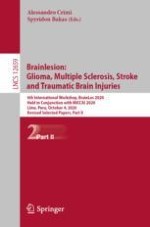2021 | OriginalPaper | Buchkapitel
An Automatic Overall Survival Time Prediction System for Glioma Brain Tumor Patients Based on Volumetric and Shape Features
verfasst von : Lina Chato, Pushkin Kachroo, Shahram Latifi
Erschienen in: Brainlesion: Glioma, Multiple Sclerosis, Stroke and Traumatic Brain Injuries
Aktivieren Sie unsere intelligente Suche, um passende Fachinhalte oder Patente zu finden.
Wählen Sie Textabschnitte aus um mit Künstlicher Intelligenz passenden Patente zu finden. powered by
Markieren Sie Textabschnitte, um KI-gestützt weitere passende Inhalte zu finden. powered by
